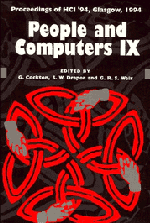Book contents
- Frontmatter
- Contents
- Preface: HCI'94 – You Probably Haven't Seen It All Before
- Part I Invited Papers
- Part II Methodology of Interactive Systems Development
- Crafting Interaction: Styles, Metaphors, Modalities and Agents
- 10 A Comparison of Placement Strategies for Effective Visual Design
- 11 Evaluation of Alternative Operations for Browsing Hypertext
- 12 On the Problem of Selecting Interaction Objects
- 13 Minimising Conceptual Baggage: Making Choices about Metaphor
- 14 Keeping an Eye on your Interface: The Potential for Eye-Based Control of Graphical User Interfaces (GUI's)
- 15 A Linguistic Approach to Sign Language Synthesis
- 16 Generalisation and the Adaptive Interface
- 17 Agent-Based Interaction
- Modelling Humans, Computers and their Interaction
- Notations and Tools for Design
- Part VI Computer-Supported Cooperative Work
- Author Index
- Keyword Index
15 - A Linguistic Approach to Sign Language Synthesis
Published online by Cambridge University Press: 04 August 2010
- Frontmatter
- Contents
- Preface: HCI'94 – You Probably Haven't Seen It All Before
- Part I Invited Papers
- Part II Methodology of Interactive Systems Development
- Crafting Interaction: Styles, Metaphors, Modalities and Agents
- 10 A Comparison of Placement Strategies for Effective Visual Design
- 11 Evaluation of Alternative Operations for Browsing Hypertext
- 12 On the Problem of Selecting Interaction Objects
- 13 Minimising Conceptual Baggage: Making Choices about Metaphor
- 14 Keeping an Eye on your Interface: The Potential for Eye-Based Control of Graphical User Interfaces (GUI's)
- 15 A Linguistic Approach to Sign Language Synthesis
- 16 Generalisation and the Adaptive Interface
- 17 Agent-Based Interaction
- Modelling Humans, Computers and their Interaction
- Notations and Tools for Design
- Part VI Computer-Supported Cooperative Work
- Author Index
- Keyword Index
Summary
This paper describes a linguistically motivated approach to synthesising animated sign language. Our approach emphasises the importance of the internal, phonological structure of signs. Representing this level of structure results in greatly reduced lexicon size and more realistic signed output, a claim which is justified by reference to sign linguistics and by examples of sign language structure. We outline a representation scheme for phonological structure and a synthesis system which uses it to address these concerns.
Keywords: deaf sign language, phonological structure, human animation.
Introduction
The sign languages used by the deaf are a striking example of the diversity of human communication. On the surface, visual-gestural languages appear entirely dissimilar to verbal languages. It is a common misconception that signs are a form of pantomime and that they cannot convey the same range of abstract meanings as words. However, research has shown that this is entirely untrue (Klima & Bellugi, 1979). Sign languages are languages in the full sense of the word with all the expressive power of verbal languages.
In this paper we present an approach to the synthesis of animated sign language which focuses on the internal structure of signs. Several authors have discussed the translation of verbal language into sign language and the visual presentation of sign language via 3D graphics (Holden & Roy, 1992; Lee & Kunii, 1992; Patten & Hartigan, 1993). However, these authors seem to regard the sign as a unit which requires no further analysis. Sign linguists tell us that signs have internal structure and are built from more fundamental units. We argue that representing this level of structure in a synthesis system is essential for the synthesis of native sign languages.
Information
- Type
- Chapter
- Information
- People and Computers , pp. 211 - 222Publisher: Cambridge University PressPrint publication year: 1994
Accessibility standard: Unknown
- 2
- Cited by
